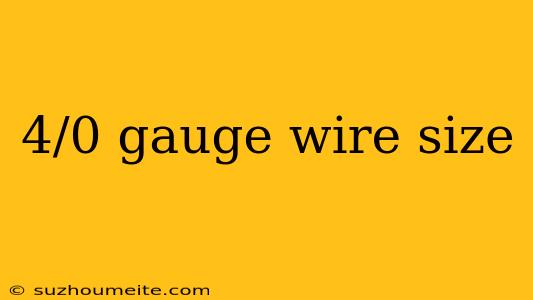4/0 Gauge Wire Size: Understanding the Specifications and Applications
When it comes to electrical wiring, gauge size is a critical factor to consider. The gauge size of a wire determines its diameter, conductivity, and current-carrying capacity. In this article, we will delve into the specifics of 4/0 gauge wire size, its applications, and what makes it unique.
What is 4/0 Gauge Wire?
4/0 gauge wire, also known as "0000" or "quad zero," is a type of electrical wire with a larger diameter than other gauge sizes. The "4/0" designation refers to the wire's American Wire Gauge (AWG) size, which is a standard system used to measure wire diameters.
Specifications of 4/0 Gauge Wire
Here are the key specifications of 4/0 gauge wire:
- Diameter: 0.4600 inches (11.68 mm)
- Cross-sectional area: 212,420 circular mils (cmil)
- Resistance: 0.0618 ohms per 1,000 feet (304.8 meters)
- Ampacity: 230-310 amps (depending on the insulation type and operating conditions)
Applications of 4/0 Gauge Wire
Due to its large diameter and high current-carrying capacity, 4/0 gauge wire is commonly used in various applications, including:
- Electrical power distribution: 4/0 gauge wire is used in high-voltage electrical power distribution systems, such as substations, transmission lines, and industrial power systems.
- Grounding systems: Its high conductivity and corrosion resistance make it an ideal choice for grounding systems, including lightning protection systems and electrical grounding grids.
- Welding and fabrication: 4/0 gauge wire is used in welding and fabrication applications, such as welding machine cables and electrode holders.
- Battery cables: Its high current-carrying capacity makes it suitable for battery cables in heavy-duty applications, such as electric vehicles and renewable energy systems.
Advantages and Considerations
The advantages of 4/0 gauge wire include:
- High current-carrying capacity: Its large diameter allows it to carry high currents without overheating or compromising its integrity.
- Low resistance: The wire's low resistance ensures efficient energy transmission and minimizes energy losses.
However, there are also some considerations to keep in mind:
- Size and weight: 4/0 gauge wire is larger and heavier than smaller gauge sizes, making it more difficult to handle and install.
- Cost: Due to its high material content and manufacturing complexity, 4/0 gauge wire is generally more expensive than smaller gauge sizes.
Conclusion
In conclusion, 4/0 gauge wire size is a critical component in various high-current applications, including electrical power distribution, grounding systems, welding, and battery cables. Its unique specifications, advantages, and considerations make it an essential choice for engineers, electricians, and technicians working with high-voltage electrical systems.
